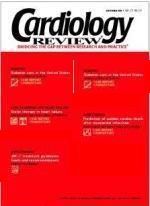Publication
Article
Cardiology Review® Online
Continuous insulin infusion in patients with diabetes undergoing CABG surgery improves glycemic control with no increase in costs
Glycemic control can be improved perioperatively in patients with diabetes who undergo coronary artery bypass graft (CABG) surgery by implementing a protocol for insulin infusion control under the supervision of an endocrinologist. The protocol was associated with trends toward improved length of stay with no increase in health-care costs, according to Amit C. Vora, MD, lead author of a study published in Endocrine Practice (2004;2:112-118).
In the study, outcomes and costs were compared in patients with
diabetes undergoing CABG who were treated either conventionally with insulin, as directed by anesthesia and surgical teams (n = 81), or underwent strict glycemic control protocols under the care of an endocrinologist (n = 107). The insulin infusion glycemic control protocol (IGCP) was an interdisciplinary clinical care pathway implemented by nurses in the surgical intensive care unit that involved routine consultation and follow-up by an endocrinologist. The goal of the IGCP was to maintain glucose levels in the range of 120 to 200 mg/dL.
As expected, the average number of glucose measurements was 23.85 in the IGCP group and 7.98 in the conventionally treated group. Glucose control was improved significantly in the IGCP group: average blood glucose values were 183.46 mg/dL in the IGCP group versus 241.67 mg/dL in the conventionally treated group (P < .001). This improvement in glycemic control was achieved without any reported episodes of severe hypoglycemia.
Length of hospital stay from admission to discharge was 8.25 days in the ICGP group and 8.64 days in patients treated conventionally, a trend that did not achieve statistical significance. In addition, there were trends in favor of the IGCP group in surgery length of stay and the incidence of deep sternal wound infections. Total hospital costs were comparable in the two groups: $21,076 and $21,442 for the IGCP and conventionally treated groups, respectively.
“The findings showed that any increased expense of endocrinology consultation and frequent glucose monitoring may have been offset by the trend toward fewer costly infections and reduction in hospital length of stays,” said Dr. Vora, from the Ambulatory Care Center in Wartburg, Tennessee, who completed the work while an endocrinology fellow at Penn State Hershey Medical Center under the direction of Robert A. Gabbay, MD, PhD, associate professor of medicine, Penn State College of Medicine, Hershey, Pennsylvania. “In our current health-care environment of evidence-based and cost-effective health-care delivery, studies related to measures of efficiency and costs are increasingly important.”
A recent retrospective study of CABG surgery patients with a mean blood glucose of 205 mg/dL showed that the risk of death, myocardial infarction, stroke, or septic complications increased by 17% for every 18 mg/dL increase in blood glucose greater than 110 mg/dL, the authors noted. They added that the target blood glucose of 120 to 200 mg/dL in the present study may have been too high to observe differences in length of stay and the incidence of deep sternal wound infections between the IGCP group and the conventionally treated group.
